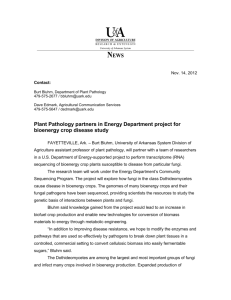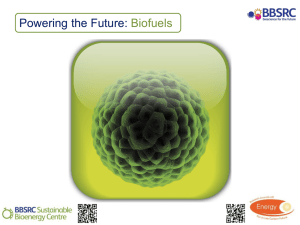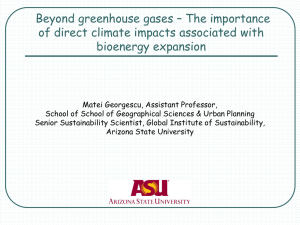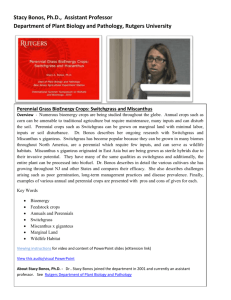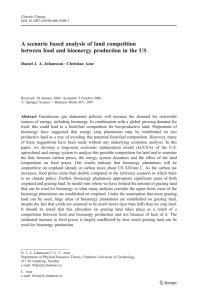Biomass Cropping Trial Experiment Summary
advertisement
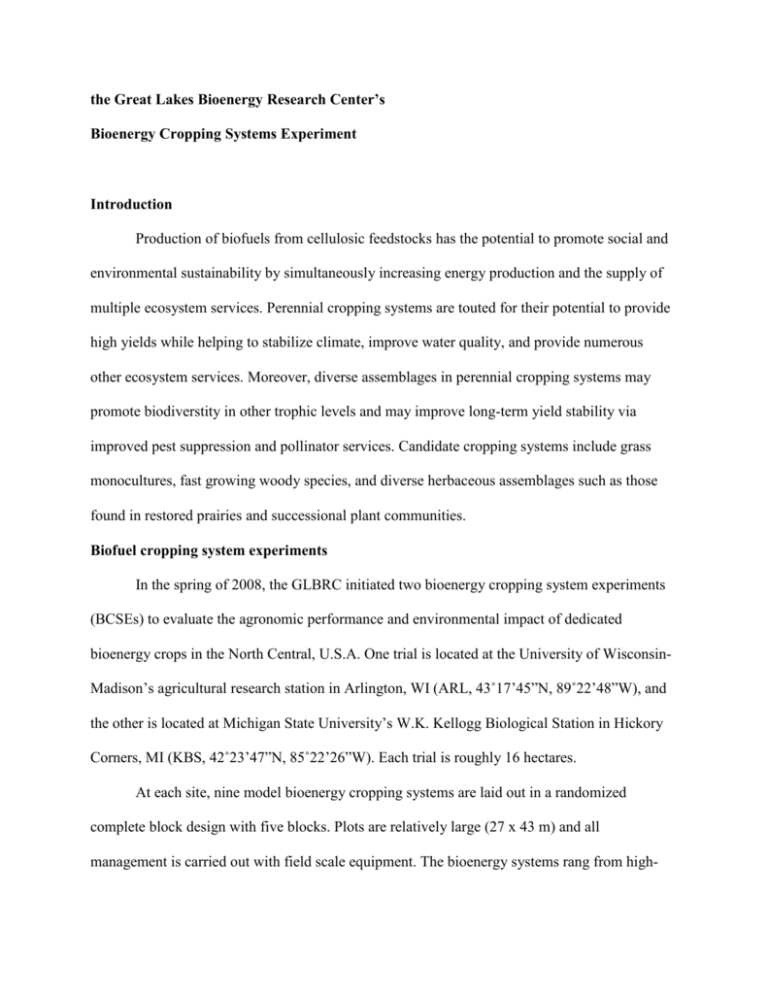
the Great Lakes Bioenergy Research Center’s Bioenergy Cropping Systems Experiment Introduction Production of biofuels from cellulosic feedstocks has the potential to promote social and environmental sustainability by simultaneously increasing energy production and the supply of multiple ecosystem services. Perennial cropping systems are touted for their potential to provide high yields while helping to stabilize climate, improve water quality, and provide numerous other ecosystem services. Moreover, diverse assemblages in perennial cropping systems may promote biodiverstity in other trophic levels and may improve long-term yield stability via improved pest suppression and pollinator services. Candidate cropping systems include grass monocultures, fast growing woody species, and diverse herbaceous assemblages such as those found in restored prairies and successional plant communities. Biofuel cropping system experiments In the spring of 2008, the GLBRC initiated two bioenergy cropping system experiments (BCSEs) to evaluate the agronomic performance and environmental impact of dedicated bioenergy crops in the North Central, U.S.A. One trial is located at the University of WisconsinMadison’s agricultural research station in Arlington, WI (ARL, 43˚17’45”N, 89˚22’48”W), and the other is located at Michigan State University’s W.K. Kellogg Biological Station in Hickory Corners, MI (KBS, 42˚23’47”N, 85˚22’26”W). Each trial is roughly 16 hectares. At each site, nine model bioenergy cropping systems are laid out in a randomized complete block design with five blocks. Plots are relatively large (27 x 43 m) and all management is carried out with field scale equipment. The bioenergy systems rang from high- input/low-diversity annual crops to low-input/high-diversity restored prairie and early successional communities. The systems include: continuous corn, corn with a rye cover crop, corn/soy with a rye cover crop, switchgrass (Panicum virgatum “Cave-in-rock”), giant miscanthus (Miscanthus x giganteus), a native grass mix (5 spp.), hybrid poplar (“NM-6”, Populus nigra x Populus maximowiczii), an early successional community, and a restored prairie (18 spp.). No-till farming practices have been in place since the trials were established in 2008. Long-term data collection at these trials is geared toward understanding the production potential of model bioenergy crops as well as their environmental and economic sustainability profiles. To accomplish this goal data is collected each season on greenhouse gas (GHG) emissions (CO2, N2O, CH4), soil N and C dynamics, carbon fixed in above- and below-ground plant biomass, total harvestable yield, soil fertility, and input/output prices. Additional projects at the BCSEs are looking at 1) the importance of mycorrhizal fungi for N use efficiency in switchgrass, 2) soil water dynamics and nutrient leaching in biofuel crops, 3) switchgrass yield response to variable N rate, 4) corn genetic selection for use in cover crop intensive annual crop rotations, 5) insect herbivory in biofuel crops, and 6) weed species dynamics in biofuel crops. Results from the first six growing seasons highlighted the difficulties that can arise while establishing perennial biomass crops and suggest that biotic and abiotic stressors are likely to be critical drivers of perennial biomass crop success. Our results also show that many perennial crops are competitive with corn stover for harvested yield and in some cases (giant miscanthus, hybrid poplar) were comparable in production to total corn biomass (grain + stover). Relatively simple changes in agronomic management such as optimized late summer harvests may provide short-term but significant gains in crop yield, while long-term yield gains in the North Central U.S. are likely to come from the development of regionally adapted plant cultivars with improved winter hardiness and disease resistance. Under similar management, N2O emissions from perennial cropping systems located on the soils with greater water and nutrient holding capacity had higher emissions. Conversely, despite inter- and intra-annual variability, continuous and rotational corn was consistently higher in N2O emissions in all of the site-years studied and under particular environmental and management conditions, emissions from these systems dwarfed all other systems. Nearly simultaneous fertilization and precipitation events resulted in substantial emissions spikes, an effect that was most clearly observed in corn. Cumulative emissions from the annual crop rotations were highly dependent on crop phase timing coincident with climatic conditions. For restored prairie, grown in the absence of fertilizer, N2O emissions were consistently low at both sites and in all years. Biofuels on marginal lands Land that is not suitable for crop production, so-called ‘marginal lands’, are often proposed as ideal locations for the sustainable production of cellulosic bioenergy crops. Biomass production on marginal lands has a number of potential benefits including limiting the competition between food and fuel production, stabilizing highly erodible or thin soils, and protecting water resources. In an effort to improve our understanding of biofuel production on marginal lands of the Northcentral U.S., the GLBRC initiated a network of Marginal Land Experiments (MLEs) in the spring of 2013. There are three sites in WI and three sites in MI arrayed along a latitudinal gradient (see map below). The choice of cropping systems to be grown on the MLE’s was based on the ongoing large scale bioenergy cropping systems experiments (BCSE) at Arlington, WI and Hickory Corners, MI which have been in place since 2008. All six cellulosic biomass crops grown at the BCSE in addition to a control (no change) are replicated in 4 blocks. The plots are 12 m x 20 m except for poplar which is 20 m x 20m. The treatments include switchgrass (Panicum virgatum “Cave-in-rock”), giant miscanthus (Miscanthus x giganteus), a native grass mix (5 spp.), hybrid poplar (“NM-6” Populus nigra x P. maximowiczii), an early successional community, and a restored prairie (18 spp.). Biomass harvest at these trials is set to begin in the fall of 2014. Data collection has been streamlined at the MLEs to include carbon fixed in aboveground plant biomass, total harvestable yield, soil fertility, and input/output prices. Tables & Figures Fig 1: 9 model bioenergy cropping systems at the BCSEs, arrayed along the primary axes of input level and species diversity. Fig 2: Map of Wisconsin and Michigan showing the location of the two biofuel cropping systems experiments (stars) and the network of six marginal land experiments (asterisks). Relevant GLBRC Sustainability Publications Egbendewe-Mondzozo A, Swinton S, Izaurrald C, et al. (2011) Biomass supply from alternative cellulosic crops and crop residues: a spatially explicit bioeconomic modeling approach. Biomass and Bioenergy, 35, 4636-4647. Gelfand I, Zenone T, Jasrotia P, et al. (2011) Carbon debt of Conservation Reserve Program (CRP) grasslands converted to bioenergy production. PNAS, 108, 13864-13869. Gelfand I, Sahajpa R, Zhang X, et al. (2013) Sustainable bioenergy production from marginal lands in the US Midwest. Nature, 493, 514-517. Hedtcke J, Sanford G, Hadley K, et al. (2014) Maximizing land use during switchgrass establishement in the North Central United States. Agron. J., 106, 596-604. Meehan T, Werling B, Landis D, et al. (2012) Pest-suppression potential of midwestern landscapes under contrasting bioenergy scenarios. PloS one, 7, e41728. Meehan T, Gratton C, Diehl E, et al. (2013) Ecosystem-service tradeoffs associated with switching from annual to perennial energy crops in riparian zones of the US Midwest. PloS one, 8: e80093. Roberston GP, Dale VH, Doering OC, et al. (2008) Sustainable Biofuels Redux. Science, 322, 49-50. Sanford GR, Posner JL, Jackson RD, et al. (2012) Soil carbon lost from Mollisols of the North Central U.S.A. with 20 years of agricultural best management practices. Agric. Ecosyst. Env., 162, 68-76. Skevas T, Swinton S, Hayden N (2014). What type of landownder would supply marginal land for energy crops? Biomass and Bioenergy, 67, 252-259. Werling BP, Dickson TL, Isaacs R, et al. (2014). Perennial grasslands enhance biodiversity and multiple ecosystem services in bioenergy landscapes. PNAS, 111, 1652-1657

